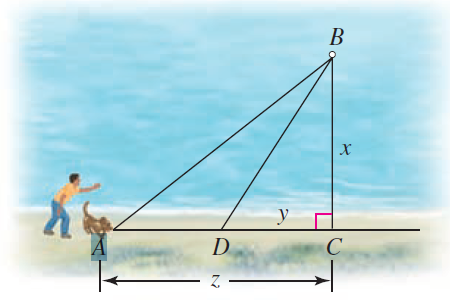A mathematician stands on a beach with his dog at point A. He throws a tennis ball
Question:
A mathematician stands on a beach with his dog at point A. He throws a tennis ball so that it hits the water at point B. The dog, wanting to get to the tennis ball as quickly as possible, runs along the straight beach line to point D and then swims from point D to point B to retrieve his ball. Assume C is the point on the edge of the beach closest to the tennis ball (see figure).

a. Assume the dog runs at speed r and swims at speed s, where r > s and both are measured in meters/second. Also assume the lengths of BC, CD, and AC are x, y, and z, respectively. Find a function T(y) representing the total time it takes the dog to get to the ball.
b. Verify that the value of y that minimizes the time it takes to retrieve the ball is

c. If the dog runs at 8 m/s and swims at 1 m/s, what ratio y/x produces the fastest retrieving time?
d. A dog named Elvis who runs at 6.4 m/s and swims at 0.910 m/s was found to use an average ratio y/x of 0.144 to retrieve his ball. Does Elvis appear to know calculus?
Step by Step Answer:

Calculus Early Transcendentals
ISBN: 978-0321947345
2nd edition
Authors: William L. Briggs, Lyle Cochran, Bernard Gillett





